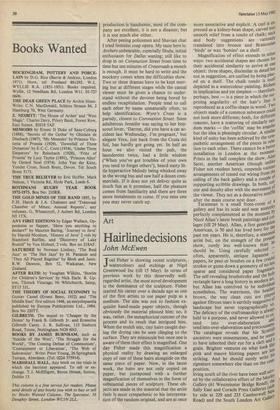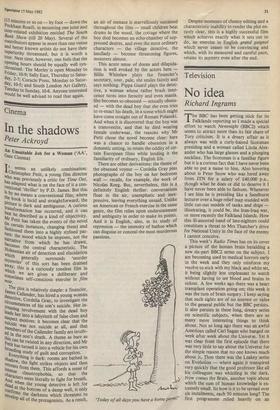Art
Hairline decisions
John McEwen
Joel Fisher is showing recent sculptures, watercolours and etchings at Nigel Greenwood Inc (till 15 May). In terms of previous work by this deservedly well- regarded artist, the most novel development is the dominance of the sculpture. Fisher started his career over a decade ago as one of the first artists to use paper pulp as a medium. The aim was not to fashion ex- quisite hand-made paper objects, though obviously the material pleased him; no, it was, rather, the metaphorical content of the process and its result that intrigued him. When the mulch sets, tiny hairs caught dur- ing the drying can be seen clinging to the surface. They are minuscule but once one is aware of them their effect is magnified. One day Fisher made this magnification a physical reality by drawing an enlarged copy of one of these hairs alongside on the same piece of paper. Now, in the latest work, the hairs are not only copied on paper, but juxtaposed with a further magnification of themselves in the form of substantial pieces of sculpture. These ob- jects are made in the material that the artist feels is most sympathetic to his interpreta- tion of the random original, and are at once Spectator 15 May 1982 more associative and explicit. A curl is ex- pressed as a kidney-bean shape, carved into smooth relief from a tondo of chalk; neck and body suggestions are variouslY translated into bronze and Brancusian 'birds' or wax 'bottles' on a shelf.
Magnification of effect extends in other ways: two accidental shapes are chosen for their accidental similarity to arrive at one object; three shapes, dissimilar in detail but not in suggestion, are unified by being plac- ed on a shelf. The chalk tondo is itself depicted in a watercolour painting. Richest in implication and yet simplest — therefore, perhaps, best — is a piece in which the sur- prising angularity of the hair's line iS reproduced as a coffin-shape in wood. Tw°, objects made of a common substance could not look more different; both, for different reasons, have a scattering of similarly ran- dom marks — the 'coffin' may be angOlar but the idea is pleasingly circular. A similar kind of unity has been achieved by the sym- pathetic arrangement of the pieces in rela- tion to each other. There cannot be a better installation in London at the moment' Prints in the hall complete the show. Alan Saret, another American (though unlike Fisher not resident here), suspends various arrangements of teased out wiring from the ceiling of the back gallery and a couple °J or supporting scribble drawings. In both, e; our and density alter with the movement of the viewer. They act as a decorative 9)06 after the main course next door. • f Taranman is a small front-room 0 - gallery and has its scale and neat austerity perfectly complemented at the moment b,Y. Nicol Allan's latest brush paintings and COr lages (till 29 May). Allan, a first generation American, is 50 and has lived here for the, past ten years. He is, therefore, a seasoned artist but, on the strength of the present show, surely less well-known than "` should be. Using carefully selected often, apparently, antique Japanese ,--, papers, he pens or brushes on a few crucial strokes or gums down a geometry of no less sparse and considered paper fragments. The self-revealing brushstroke and the 1101Y rectangle have a long history in modern art' but Allan has contrived to be individual nonetheless. The wateriness, the beathe,. ' brown, the way clean cuts are Played against fibrous tears is earthily suggestive ° landscape but never topographically s°: The delicacy of the craftsmanship is alwaP held to a purpose, and never allowed to eXci
tend into over-elaboration an
,5 tend into over-elaboration and preciousne',; The catalogue reveals that his Scottisl! ancestors were stonemasons, and he see! to have inherited their eye for a cleft and .,: grain. Brighter ventures on what look II% pink and mauve blotting papers are leis striking. And he should surely write 11 signature somewhere else than on the co position. living south of the river have been well serv- ed by the collaborative effort of the Mori,,,eYe Gallery (61 Westminster Bridge Road), Sally East and Coracle Press Galleries (stuo, by side at 229 and 233 Camberwell Ns, Road) and the South London Art Gaiter' (15 minutes or so on — by foot — down the Peckham Road), in mounting one joint and inter-related exhibition entitled The South Bank Show (till 20 May). Several of the contributors appear in more than one venue and better known artists do not have their superiority threatened, but it is worth a tour. Next time, however, one feels that the oPening hours should be equally well syn- chronised. The Morley is open Monday to Friday, 10-9; Sally East, Thursday to Satur- day, 2-7; Coracle Press, Monday to Satur- day, 10-5; and South London Art Gallery, Tuesday to Sunday, 10-6. Anyone interested would be well advised to read that again.







































 Previous page
Previous page